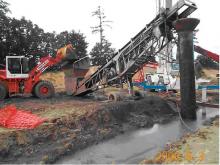Adatszolgáltató
Budapesti Műszaki és Gazdaságtudományi Tanszék, Alkalmazott Biotechnológia és Élelmiszertudományi Tanszék, Környezeti Mikrobiológia és Biotechnológia Kutatócsoport
Elérhetőség
Technológia fő adatlapja
A fejlesztés finanszírozása
Alkalmazási kör
- Halogénezett alifás szerves vegyületek
- triklóretilén
Csökkentendő környezeti kockázat jellemzése
Technológiára vonatkozó információ
In the construction of a 7.6 m long, 0.8 m wide and 10.4 m deep experimental permeable reactive barrier (PRB), 90/10% iron/sand mixture was placed into the trench using a tremie pipe (Sivavec et al., 2002). Sand and granular iron (Conelly-GPM, -8+50 mesh) were mixed at the site using concrete-mixing trucks. The reactive material was placed in the trench using tremie pipes. Care was taken to minimize segregation and contact between the iron/sand mixture and the biopolymer. Following placement high pH enzyme breaker (Rantec LEB-H, 3.81) was added to the fluid to break the remaining biopolymer in the trench and clay was placed on the barrier to prevent contact with air.
Biopolymers were first used as additives to stabilise trench walls during excavation. Through the advancements achieved by their use, the additive application has been developed into a new technology. The procedure exhibits similar features to traditional slurry trenching, the main difference being that biopolymer (e. g. guar gum) is added to the stabilising suspension and enzyme breaker used to break the remaining biopolymer.
Technológia besorolása
- felszín alatti reaktív résfal vagy gát vagy réteg vagy zóna
- felszín alatti reaktív résfal (PRB) (egyszerű)
Technológia-monitoring
Technológia költségei
SWOT (értékelés osztályzattal)
SWOT (szöveges értékelés)
Improved slurry trenching technology for PRB which uses biopolymer to enhance trench stabilisation during excavation and enzyme breaker following placement of the reactive material.
Potential segregation of sand and iron during placement.
Technology enhancement for PRB construction.
None.
Konkrét megvalósult alkalmazások
Publikáció, referencia
Sivavec, T., Krug, T, Berry-Spark, K. and Focht, R. (2002) Performance monitoring of a permeable reactive barrier at the Somerworth Sanitary Landfill Superfund Site. In: Simon, F.G., Meggyes, T., McDonald, C. (eds) Advanced groundwater remediation. Thomas Telford Publishing. London. 87 - 100.
Sivavec, T.M. (2001) Long-Term Performance Monitoring of Permeable Reactive Barriers, Prepr. Paper ACS Natl. Meeting, Am. Chem. Soc., Div. Environ. Chem. 41(1), 1181-1184.
